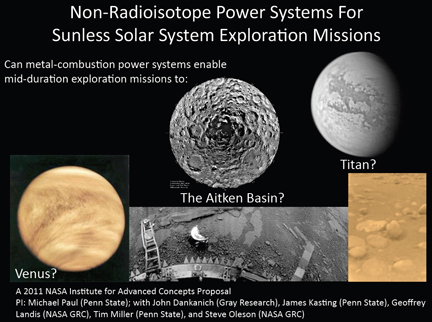NIAC 2011 Phase I Paul Final Report
Michael Paul
Pennsylvania State University
Several targets of interest in solar system exploration require non-solar power sources due to permanent shading from craters or clouds or due to extreme distance from the sun. These missions are typically considered with radioisotope power sources, but the scarcity of such fuel reduces the number of missions that NASA can execute in any decade. This study will explore mission architectures to the Moon’s southern Aitken Basin, the surface of Saturn’s moon, Titan, and the surface of Venus that do not rely on Plutonium for power, but instead are powered by a metal-combustion engine. The Applied Research Lab at Penn State has been developing advanced metal combustion systems for power generation through turbines and Sterling engines that have significantly higher energy density than chemical batteries. This NIAC study team will chose one of these missions to study in detail at the NASA Glenn Research Center’s COMPASS Lab, resulting in a mission concept report. Proving the feasibility of using metal combustion to power spacecraft in sunless regions would be a breakthrough and shift our expectation of what explorations are possible through Discovery and New Frontiers missions without relying on radioisotope power sources.































